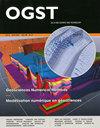利用混合地震方法、声波测井和流量测井测量来描述裂缝含水层前100米深度的流动特征
IF 1.8
4区 工程技术
Q4 ENERGY & FUELS
Oil & Gas Science and Technology – Revue d’IFP Energies nouvelles
Pub Date : 2021-01-01
DOI:10.2516/ogst/2021048
引用次数: 3
摘要
了解地下流动,特别是在只有少数优先通道的裂缝岩石中,仍然具有挑战性。这主要与地下可达性差、含水体的非均质性和空间分布缺乏准确表征有关。尽管如此,高分辨率的地球物理调查带来了地下的新图像。这是在现场尺度上(例如,抽取井的影响半径)的断裂石灰岩含水层的例子。在谢尔地区(法国)的一个实验场地,钻了两个钻孔进行现场实验。进行了全波形声波测井(FWAL)和地震实验。混合地震成像是将折射和反射地震结果结合起来进行的。基于四步程序,折射波和反射波的处理分为两部分。在组合后,这些剖面在第一步中从地面开始进行长时间反射率剖面,在第二步中,在垂直地震剖面(VSP)和声学数据校准后进行深度剖面。然而,即使是非常高分辨率(VHR)地震方法也没有足够的垂直分辨率来准确描述地质构造。对声波剖面进行处理,分离不同的波场,提取交叉事件,建立交叉指数测井曲线。基于纵横指数和纵波速度测量,计算裂缝指数的对数,以检测裂缝的存在。校正后,在假设纵波速度越慢,渗透率-孔隙度越高的情况下,三维反射地震块可以告知应该发生流动的优先区域。在裸眼井中,声波测井可以测量井内短距离内的波速,同时也可以显示井的裸眼特征。最后,流量测井测量证实了流动层的存在,这些流动层以前是由地震和声波数据标记的。因此,地震和声学数据适用于裂缝地下系统的水力特性对比图像,通常文献很少。本文章由计算机程序翻译,如有差异,请以英文原文为准。
Characterizing flow in the first hundred-meter depth of a fractured aquifer using hybrid seismic methods, acoustic logging, and flow-log measurements
Understanding subsurface flow, especially in fractured rocks only housing water through a few preferential pathways, is still challenging. The point is mainly associated with the poor accessibility of the subsurface and the lack of accurate representations for both heterogeneity and spatial distribution of water bearing bodies. This notwithstanding, highly-resolved geophysical investigations bring new images of the subsurface. This is exemplified over a fractured limestone aquifer at the site scale (for example, that of the radius of influence of an extraction well). On an experimental site, situated in the Cher region (France), two boreholes have been drilled for field experiments. Full Waveform Acoustic Logging (FWAL) and seismic experiments were conducted. Hybrid seismic imaging, which consists in combining refraction and reflection seismic results, has been carried out. Based on a four-step procedure, the processing of refracted and reflected waves provided two sections. After assemblage, these sections produced in a first step an extended time reflectivity section starting from the surface and, in a second step, a section over depth after calibration with Vertical Seismic Profile (VSP) and acoustic data. However, even the Very High Resolution (VHR) seismic methods do not have a sufficient vertical resolution to describe accurately the geological formation. The acoustic sections were processed to separate the different wave fields, to extract the criss-cross events and to build a criss-cross index log. A log of fracturation index, based on both criss-cross index and P-wave velocity measurements, was computed to detect the presence of fractures. After calibration, and under the assumption that the slower the P-wave velocity, the higher the permeability – porosity, a 3D seismic block of reflection can inform on preferential areas where flow should occur. At the scale of an open wellbore, acoustic loggings that measure wave velocities over a short distance within the well also inform on open features crosscut by the well. Finally, flow log measurements confirm the occurrence of flowing horizons that were previously marked by both seismic and acoustic data. Seismic and acoustic data are therefore suited to image contrasted hydraulic properties over fractured subsurface systems usually poorly documented.
求助全文
通过发布文献求助,成功后即可免费获取论文全文。
去求助
来源期刊
CiteScore
2.70
自引率
0.00%
发文量
0
审稿时长
2.7 months
期刊介绍:
OGST - Revue d''IFP Energies nouvelles is a journal concerning all disciplines and fields relevant to exploration, production, refining, petrochemicals, and the use and economics of petroleum, natural gas, and other sources of energy, in particular alternative energies with in view of the energy transition.
OGST - Revue d''IFP Energies nouvelles has an Editorial Committee made up of 15 leading European personalities from universities and from industry, and is indexed in the major international bibliographical databases.
The journal publishes review articles, in English or in French, and topical issues, giving an overview of the contributions of complementary disciplines in tackling contemporary problems. Each article includes a detailed abstract in English. However, a French translation of the summaries can be provided to readers on request. Summaries of all papers published in the revue from 1974 can be consulted on this site. Over 1 000 papers that have been published since 1997 are freely available in full text form (as pdf files). Currently, over 10 000 downloads are recorded per month.
Researchers in the above fields are invited to submit an article. Rigorous selection of the articles is ensured by a review process that involves IFPEN and external experts as well as the members of the editorial committee. It is preferable to submit the articles in English, either as independent papers or in association with one of the upcoming topical issues.

 求助内容:
求助内容: 应助结果提醒方式:
应助结果提醒方式:


